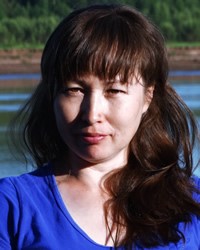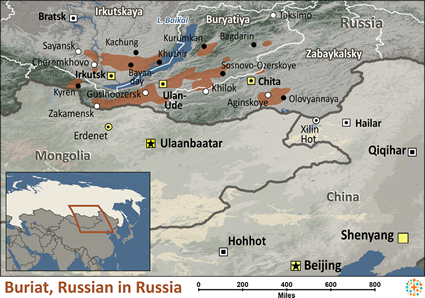The Buryat are probably descended from Mongols who moved north to escape the rule of the Mongol empire, as there is a similarity of features and language.
Today the Buryat have incorporated Mongolian, Tibetan, and Chinese elements into their own culture. Russians arrived in Siberia in the 17th century and did little to destroy the culture until the 20th century, when communism was introduced. A large percentage of Buryat live in the lowlands along the Russia-Mongolia border. This area is called the Republic of Buryatia, an “autonomous” region within the Russian Federation. The capital is Ulan-Ude, and there is a large concentration of Russian Buriats living there.
The Buryat traditionally have been nomadic herdsman. The Western Buryats have largely abandoned this lifestyle, and have settled into permanent villages, learning farming from the Russians. The Eastern Buryats remain cattle herders. Large herds of cattle, horses, reindeer, pigs, sheep, goats, and camels are moved several times a year because of the seasons of short, hot summers and long, harsh winters. A family may live in four or five different permanent houses each year, often resembling the traditional round felt tents or yurts.
Like other Mongolian peoples, Buryat eat mainly mutton, airag (fermented mare's milk), yoghurt and cheese, sausages, and a flour dough cooked in butter.
Much of the area where the Buryat live is covered with forest, and many work in the lumber industry. Each family prepares mountainous heap of logs, as homes are heated by a central wood stove which is also used in cooking. Coal is another source of energy used among Russian Buriats. Remote mountain villages may lack plumbing and other utilities.
The capital, Ulan-Ude, is an industrial center. It is home to a large meat-packing plant, railroad car shop, glass factory, power plants and flour mill. Many Buryat that work in the city are highly educated, and they excel in the fields of science, medicine, teaching, engineering, business and government. Ulan-Ude is also a cultural center. There are five popular theatres, a philharmonic and several museums.
Today, Russian Buriats wear colorful native clothing of bright blue, red, green, and orange silks and brocades at festivals. On a regular day they wear standard Western clothing including shawls and warm hats.
Buryat society was founded on the clan or lineage, and a man's home, his political position, inheritance, and status were largely determined by his clan membership. Traditionally, marriages were arranged by parents, forming alliances between clans, since members could not marry within their own lineage. A bride could also be taken by abduction, with or without her consent. Today, most marriages are initiated by the couples themselves. The Buryat love music, folk dances, chess and sporting events.
Buryats can be Tibetan Buddhists, but in Russia they are more likely to adhere to their traditional shamanistic religion. They are also somewhat Russified, and some adhere to the Russian Orthodox Church. A very small number are Evangelical; there is one Buryat church so far as we know. The vast majority have put their faith in the work of shamans and the power of the spirit world. Few have put their faith in the power and goodness of the Lord Jesus Christ.
In recent decades there has been mission efforts, but the work is incomplete. The Russian Buryats need loving workers who will stay until they have a church that is strong enough to reproduce on its own. There are many gospel tools like gospel recordings to get them started.
Pray for a team of loving, dedicated gospel workers to go to the Russian Buriats.
Pray for the conversion of intellectual Buryats in the capital of Ulan-Ude.
Pray the Buriats will be given a growing hunger to know truth; Jesus is the personification of truth.
Pray for Buriat Christ followers to take their faith to those who have put their faith in the spirit world.
Scripture Prayers for the Buriat, Russian in Russia.
| Profile Source: Joshua Project |


























